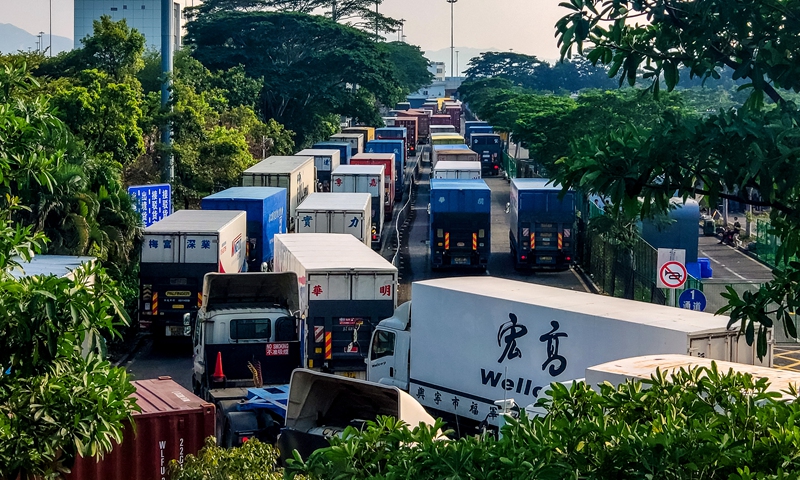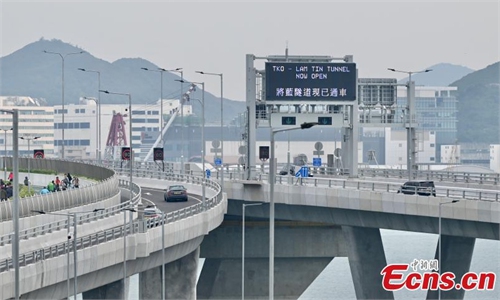
Trucks exit Shenzhen Bay Port on February 14, 2022 in Shenzhen, South China’s Guangdong Province. Photo: VCG
Cross-boundary logistics between the Hong Kong Special Administrative Region and South China’s Guangdong Province have significantly improved, said truck drivers on Monday, after authorities from both sides announced plans to simplify transport arrangement to a “point-to-point” mode.
According to Hong Kong’s Transport & Logistics Bureau, starting Monday, the cross-boundary goods vehicle (CBGV) transport arrangement will be adjusted to a point-to-point mode, under which drivers are allowed to pick up or deliver goods directly from or to the operation points, instead of handing over their vehicles to Chinese mainland drivers at the boundary and letting them finish the journey.
“No quota will be imposed for such an arrangement,” the bureau said in a statement, noting that the adjustment aims to facilitate the import and export of goods as well as cross-boundary logistics in the Guangdong-Hong Kong-Macao Greater Bay Area so as to benefit the economic development of the two sides.
Under the new arrangement, the clearance time is now five hours shorter than before, a truck driver surnamed Xie told the Global Times on Monday. Xie moves goods between Hong Kong and Guangdong.
The improvement of logistics between Hong Kong and the Chinese mainland will help boost the recovery of the city’s economy, given that the mainland has been the primary source of momentum for Hong Kong’s growth, said Liang Haiming, chairman of the China Silk Road iValley Research Institute.
It will also improve related sectors’ employment situation in Hong Kong, Liang told the Global Times on Monday.
Against the backdrop of the country optimizing its COVID-19 response, it is expected that logistics and other exchanges will resume and improve between Hong Kong and the Chinese mainland. An accelerated integration of development of the Guangdong-Hong Kong-Macao Greater Bay Area is highly anticipated, Dong Dengxin, director of the Finance and Securities Institute of the Wuhan University of Science and Technology, told the Global Times on Monday.
By promoting integrated development in the economic, trade and financial sectors, it will unleash huge potential for the growth of the Greater Bay Area, Dong said.
China unveiled the outline development plan for the Greater Bay Area in February 2019, aiming to develop the region into "a role model of high-quality development" in the country. It comprises the two special administrative regions of Hong Kong and Macao and nine cities in Guangdong.
With connectivity continuously improving within the area, more and more young people from Hong Kong and Macao are coming to mainland cities within the Greater Bay Area to study, work and live. The economic size of the area grew from about 10 trillion yuan ($1.4 trillion) in 2018 to 12.6 trillion yuan in 2021, according to the Xinhua News Agency.
Global Times


